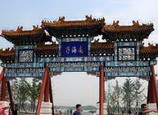
A banker with JPMorgan for many years, Van Wassenhove has always harbored a passion for art and architecture. The three all felt the urge to do something for the city they have chosen to live in.
"As we walked by chance into the Zhizhu Temple, my partners and I, under the overwhelming decay, could see beautiful remains of wooden architecture awaiting careful and authentic restoration," Van Wassenhove said.
For the next five years, the trio worked with carpenters and painting restorers from Nanjing, construction workers in Beijing and master designers from the US to renovate the complex.
A total of 400 truckloads of debris was removed, 43,000 roof tiles cleaned and replaced by hand, and 70 painted wooden panels restored — each beam being measured precisely to identify the degree of damage and to ensure that no old material was wasted.
"We tried our best to preserve the originality of the place. We really wanted to apply this concept of ‘restore the old as old' and to respect the layers of history," Van Wassenhove said. "It's not always reasonable in terms of cost, but this is a way of respecting the city."
In the end, the shrines, factory mill and political graffiti were all preserved.
"It's part of the history. We consider ourselves as guardians of this place. We are here to preserve, not to judge," Van Wassenhove said.
Beijing architectural historian Cui Jinze said the Temple Hotel project could provide the inspiration for architectural renovation in China.
"The example of the Temple Hotel shows it is technically possible to preserve the original nature of Chinese wooden architecture," Cui said.
It is also a good illustration of how a cultural relic can serve both commercial and public purposes, Cui added.
"There are many restaurants at cultural relics in China that don't allow public visits. Among the cases I have investigated in the country, Zhizhu Temple is the best example in terms of architectural preservation, business operation and public interest. Business is not necessarily a bad thing, as it goes hand in hand with the promotion of culture."
Van Wassenhove attributes the success of the project to his Chinese peers.
"When talking about China, people think of cheap products, but we want to prove that Chinese excellence exists. For this place, nothing would have been possible without these Chinese carpenters, masons, painting restorers and private sponsors," he said.

















 Developer razes historic Guangzhou structures
Developer razes historic Guangzhou structures


![]()
